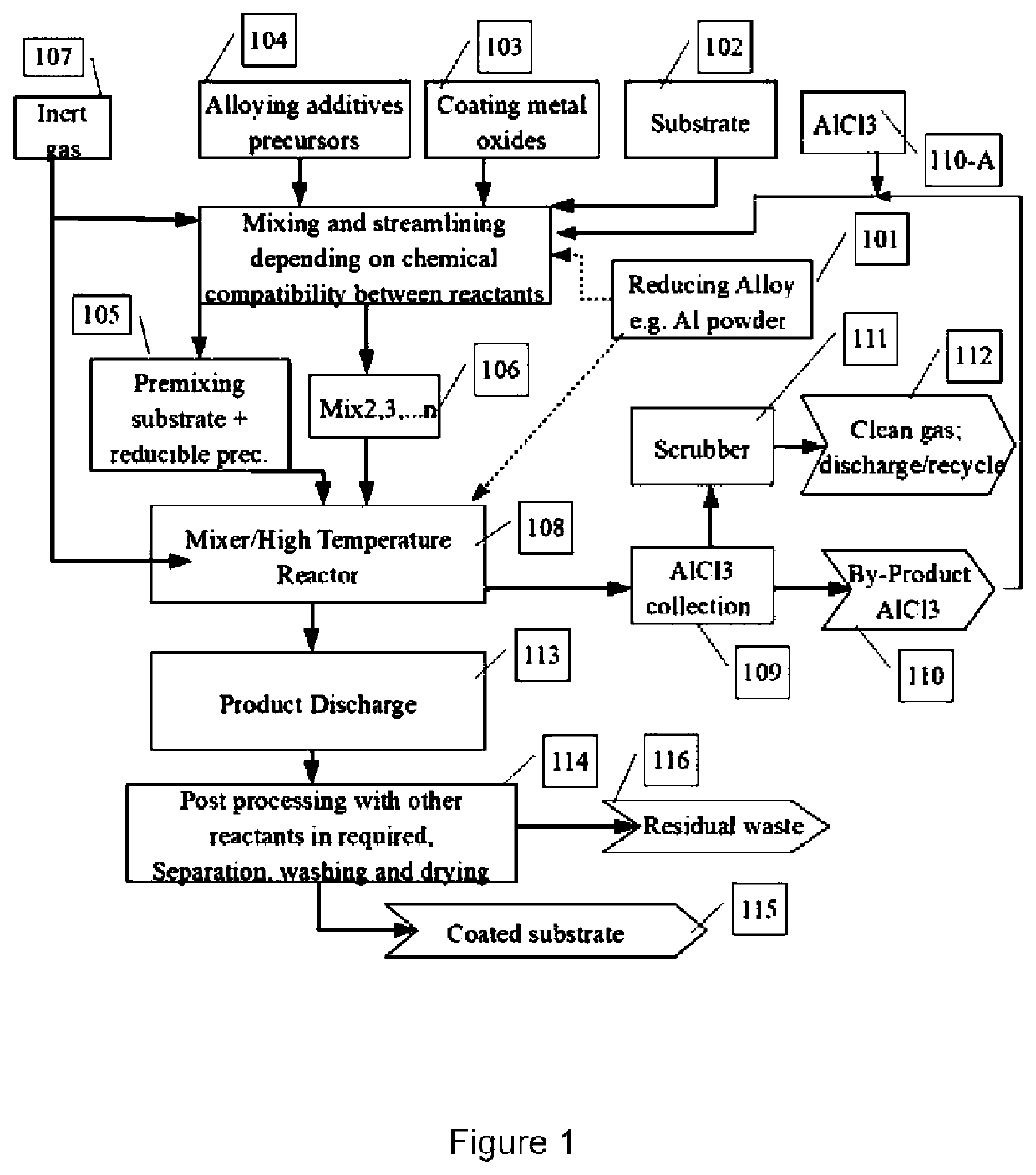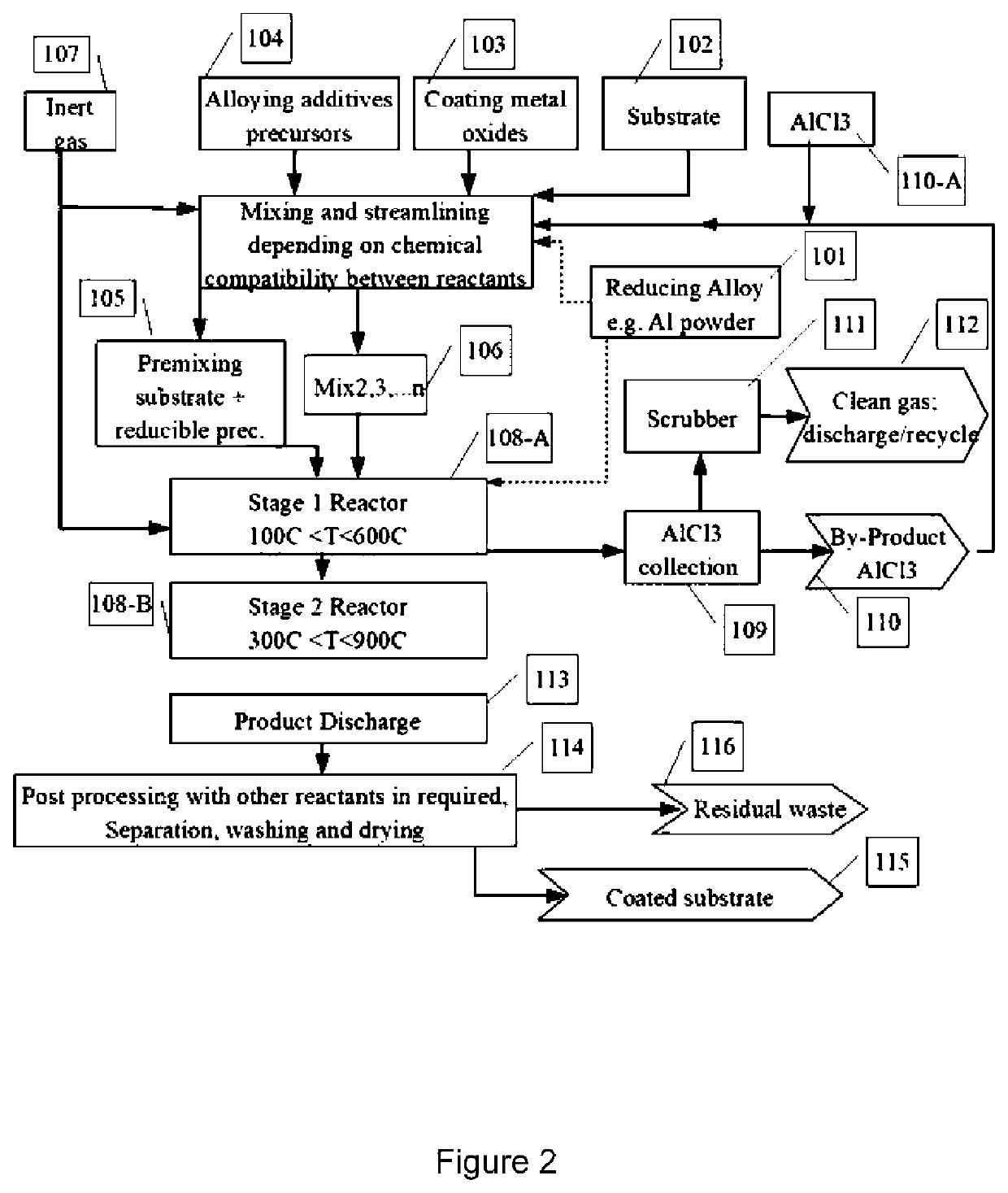Thermochemical synthesis of metallic pigments
a technology of metallic pigments and thermochemical synthesis, which is applied in the field of coating materials, can solve the problems of limited use of pvd and cvd materials, limited preparation of these materials, and high cost of pvd and cvd, so as to promote the adhesion of elemental mc species, improve the quality of coating, and maximise reaction
- Summary
- Abstract
- Description
- Claims
- Application Information
AI Technical Summary
Benefits of technology
Problems solved by technology
Method used
Image
Examples
example 1
SS FLAKES
[0176]200 g of borosilicate glass flakes are mixed together with 20 g of TiO2 powder, 10 g of Al and 20 g of AlCl3 powder.
[0177]The mixture was then fed and reacted in a continuous reactor at temperatures ramping from room temperature to 600° C. The coated flakes were then washed in water and dried. The coated flakes have metallic appearance. Examination under an SEM and EDX shows the presence of metallic Ti, TiO— Ti-l / and Ti—Si species including the presence of lumps of metallic Ti. Al was also detected in the sample.
example 2
SS FLAKES
[0178]200 g of soda-lime glass flakes are mixed together with 20 g of TiO2 powder and 10 g of Al powder (4 microns).
[0179]The mixture was then fed and reacted in a continuous reactor at a temperature ramping from room temperature to 600° C. with a residence time of 20 minutes. The coated flakes were then washed in water and dried. The coated flakes have metallic appearance. Examination under an SEM and EDX shows that the surface is coated with metallic Ti but with the presence of Ti-based metallic lumps. Al was also detected in the sample. XRD analysis of the sample indicates the presence of residual TiO2.
example 3
SS FLAKES
[0180]200 g of borosilicate glass flakes.
[0181]20 g CuO.
[0182]18 g of AlCl3 mixture (1 wt part Al to 2 part AlCl3 per weight). Al is 4 microns.
[0183]The CuO—AlCl3 were mixed with the flakes (6 microns) and then the resulting reactant mixture was heated in a continuous reactor at 600° C. (residence time=30 minutes). The coated flakes were then washed and dried. The end products have a deep marron colour consisting of a mixture of Cu, Cu2O and CuO.
[0184]EXAMPLE 4: Cu ON BOROSILICATE GLASS FLAKES
[0185]150 g borosilicate glass flakes.
[0186]30 g of a CuO.
[0187]30 g of AlCl3.
[0188]7 g of Al powder (4 microns).
[0189]The flakes, the AlCl3 and CuO are first mixed together, and then fed together with the Al into a first reactor set at 180° C. for a residence time of 15 min. The resulting intermediates are then transferred into a second reactor at a temperature 600° C. for another 15 min. In both reactors, the reactants are continuously mixed.
[0190]The products are then discharged and...
PUM
| Property | Measurement | Unit |
|---|---|---|
| Temperature | aaaaa | aaaaa |
| Temperature | aaaaa | aaaaa |
| Temperature | aaaaa | aaaaa |
Abstract
Description
Claims
Application Information
 Login to View More
Login to View More - R&D
- Intellectual Property
- Life Sciences
- Materials
- Tech Scout
- Unparalleled Data Quality
- Higher Quality Content
- 60% Fewer Hallucinations
Browse by: Latest US Patents, China's latest patents, Technical Efficacy Thesaurus, Application Domain, Technology Topic, Popular Technical Reports.
© 2025 PatSnap. All rights reserved.Legal|Privacy policy|Modern Slavery Act Transparency Statement|Sitemap|About US| Contact US: help@patsnap.com


